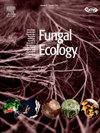白桦圆蚧(双翅目:绢蚧科)及其周围寄主组织(白僵菌和白僵菌)诱导的瘿内内生真菌多样性
IF 2.2
3区 环境科学与生态学
Q3 ECOLOGY
引用次数: 0
摘要
白桦瘿蚊在产卵过程中沉积内生真菌。然而,它们的真菌关联、寄主植物间EF的多样性以及它们之间潜在的相互作用仍然知之甚少。对两种寄主(Borrichia frutescens和Iva frutescens)的虫瘿和组织进行了调查,分类并比较了其多样性。分子测序(ITS 1-4)和培养鉴定出21个真菌属,其中子囊菌属95.6%,担子菌属4.4%。所有样品中均分离到镰刀菌(镰刀菌),相对丰度为36 - 63%,而在胆样品中最富集的是Botryosphaeria dothidea(9 - 11%)、Cladosporium sp.(11 - 13%)、Alternaria sp.(4%)和Clonostachys sp.(2 - 6%)。在果菇的胆壁组织和非胆壁组织中均发现了斑点球孢菌。果子露的胆酸多样性显著高于其他植物(p <;0.000573)。未来的研究应该探索宿主转换或关联后障碍如何影响EF传播或社区。进一步了解这些关联将有助于更广泛地研究EF分布和真菌-植食性昆虫的生命周期。本文章由计算机程序翻译,如有差异,请以英文原文为准。
Endophytic fungal diversity within galls induced by Asphondylia borrichiae (Diptera: Cecidomyiidae) and their surrounding host tissues (Borrichia frutescens and Iva frutescens)
Asphondylia borrichiae gall midges deposit endophytic fungi (EF) during oviposition. However, their fungal associations, EF diversity across host plants, and potential interactions between them all remain poorly understood. Galls and tissues from two hosts (Borrichia frutescens and Iva frutescens) were surveyed to catalog and compare EF diversity. Molecular sequencing (ITS 1–4) and culturing identified 21 fungal genera: 95.6 % Ascomycota and 4.4 % Basidiomycota. Fusarium spp. were isolated from all sample sets (36–63 % relative abundance), while Botryosphaeria dothidea (9–11 %), Cladosporium sp. (11–13 %), Alternaria sp. (4 %), and Clonostachys sp. (2–6 %) were most abundant in gall samples. Botryosphaeria dothidea was found in both gall-lining and non-gall tissues of B. frutescens. Gall EF diversity was significantly higher in B. frutescens (p < 0.000573). Future research should explore how host-switching or post-associational barriers might influence EF transmission or communities. Further understanding these associations will inform broader studies on EF distributions and myco-phytophagous insect life cycles.
求助全文
通过发布文献求助,成功后即可免费获取论文全文。
去求助
来源期刊

Fungal Ecology
环境科学-生态学
CiteScore
5.80
自引率
3.40%
发文量
51
审稿时长
3 months
期刊介绍:
Fungal Ecology publishes investigations into all aspects of fungal ecology, including the following (not exclusive): population dynamics; adaptation; evolution; role in ecosystem functioning, nutrient cycling, decomposition, carbon allocation; ecophysiology; intra- and inter-specific mycelial interactions, fungus-plant (pathogens, mycorrhizas, lichens, endophytes), fungus-invertebrate and fungus-microbe interaction; genomics and (evolutionary) genetics; conservation and biodiversity; remote sensing; bioremediation and biodegradation; quantitative and computational aspects - modelling, indicators, complexity, informatics. The usual prerequisites for publication will be originality, clarity, and significance as relevant to a better understanding of the ecology of fungi.
 求助内容:
求助内容: 应助结果提醒方式:
应助结果提醒方式:


